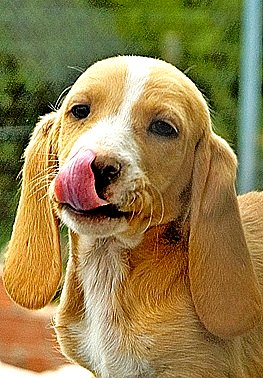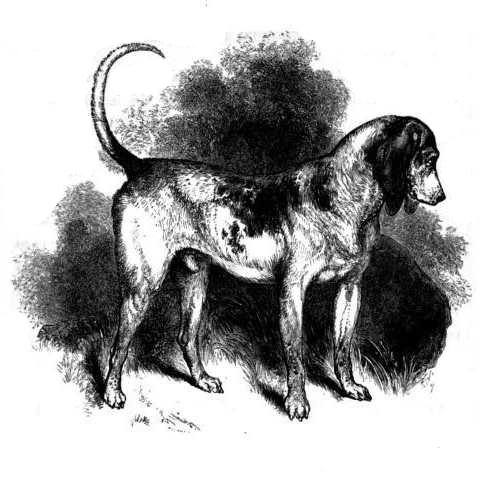|
Sabueso Español
The Sabueso Español or Spanish Hound is a scenthound breed with its origin in the far north of Iberian Peninsula. This breed has been used in this mountainous region since hundreds of years ago for all kind of game: wild boar, hare, brown bear, wolf, red deer, fox, roe deer and chamois. It is an exclusive working breed, employed in hunting with firearms. History The first description of Iberian scenthounds appears in chapter 39 of ''Libro de la Montería de Alfonso XI'' or ''The Hunting Book of Alfonso XI'', a medieval tome of the 14th century for a Castillian king. After that, diverse descriptions of Iberian scenthounds appeared in various Spanish hunting books of the 15th, 16th, and 17th centuries: two examples include ''Tratado de la Montería'', or ''A Treatise on Hunting'' and Molina's late Renaissance book ''Discurso de la Montería'', or ''A Discourse on Hunting'', written in 1582. During these centuries Spanish scenthounds of the type that would become the Sabues ... [...More Info...] [...Related Items...] OR: [Wikipedia] [Google] [Baidu] |
Real Sociedad Canina De España
is the Spanish kennel club. It was founded in Madrid as the on 27 June 1911, and became a legal entity on 12 July 1911; on 1 December 1911 it received the royal patronage of Alfonso XIII, and the word 'Real' was added before the name. It has been a full member of the Federation Cynologique Internationale A federation (also known as a federal state) is a political entity characterized by a union of partially self-governing provinces, states, or other regions under a central federal government (federalism). In a federation, the self-governi ... since 30 May 1912. It has responsibility for the registration of all dogs in Spain. References 1911 establishments in Spain Fédération Cynologique Internationale Organisations based in Spain with royal patronage Organisations based in Madrid Organizations established in 1911 Kennel clubs {{Spain-stub ... [...More Info...] [...Related Items...] OR: [Wikipedia] [Google] [Baidu] |
Montería (hunt)
A montería (, ), is an ancient type of driven hunt endemic to Spain. It involves the tracking, chase and killing of big-game, typically red deer, wild boar, fallow deer and mouflon. A number of "rehalas" (packs of hounds) along with their respective "rehaleros" (unarmed beaters) will stir up an area of forest with the aim of forcing the game to move around and into the shooting pegs, where hunters will be able to fire. The earliest records of monterías date back to the Late Middle Ages in the Crown of Castile, as can be seen with king Alfonso XI and his "Libro de la montería", published in the first half of the 14th century. Modern monterías in the Spanish sense are the result of around 300 years of evolution from the most primitive hunts that were common in the Middle Ages. As of today, two types of monterías exist; namely the "montería española" or "a la española", practised throughout the southern half of Spain and Portugal and the "montería norteña", typical of ... [...More Info...] [...Related Items...] OR: [Wikipedia] [Google] [Baidu] |
Rare Dog Breeds
A dog breed is a particular strain of dog that was purposefully bred by humans to perform specific tasks, such as herding, hunting, and guarding. Dogs are the most variable mammal on Earth, with artificial selection producing around 450 globally recognized breeds. These breeds possess distinct traits related to morphology, which include body size, skull shape, tail phenotype, fur type, body shape, and coat colour. Their behavioral traits include guarding, herding, and hunting, and personality traits such as hyper-social behavior, boldness, and aggression. Most breeds were derived from small numbers of founders within the last 200 years. As a result, today dogs are the most abundant carnivore species and are dispersed around the world. A dog breed will consistently produce the physical traits, movement and temperament that were developed over decades of selective breeding. For each breed they recognize, kennel clubs and breed registries usually maintain and publish a breed sta ... [...More Info...] [...Related Items...] OR: [Wikipedia] [Google] [Baidu] |
FCI Breeds
FCI may refer to: Companies and organizations * Falling Creek Ironworks, the first iron production facility in North America * Family Carers Ireland, Irish lobbying group * Federal Correctional Institution, part of the United States Bureau of Prisons * Fédération Cynologique Internationale, the World Canine Federation * Fertilizer Corporation of India, an Indian government-owned corporation * Fluid Components International, an American manufacturing company * Food Corporation of India, an Indian government-owned corporation * Francis Crick Institute, a British biomedical research centre * Fujisankei Communications International, an American media company Sports * F.C. Indiana, an American soccer team * FC Ingolstadt 04, a German football club * FCI Tallinn, an Estonian football club * Food Corporation of India F.C., an Indian football club * Italian Cycling Federation (Italian: ) Standards and measures * Facility condition index, in building management * fCi, the sym ... [...More Info...] [...Related Items...] OR: [Wikipedia] [Google] [Baidu] |
Basset Hound
The Basset Hound is a short-legged breed of dog in the hound family. The Basset is a scent hound that was originally bred for the purpose of hunting hare. Their sense of smell and ability to ''ground-scent'' is second only to the Bloodhound.Hart, Ernest H. ''This Is the Basset Hound'', T.F.H. Books, 1974. Basset Hounds are one of six recognized " basset"-type breeds in France. The name ''Basset'' is derived from the French word ''bas'', meaning 'low', with the attenuating suffix ''-et''—together meaning 'rather low'. Basset Hounds are usually bicolours or tricolours of standard hound coloration. Description Appearance Bassets are large, short, solid and long, with curved sabre tails held high over their long backs. An adult dog weighs between . This breed, relative to its size, is heavier-boned than any other. This breed, like its ancestor the Bloodhound, has a hanging skin structure, which causes the face to tend to have a sad look; this, for many people, adds to the ... [...More Info...] [...Related Items...] OR: [Wikipedia] [Google] [Baidu] |
Beagle
The beagle is a breed of small scent hound, similar in appearance to the much larger foxhound. The beagle was developed primarily for hunting hare, known as beagling. Possessing a great sense of smell and superior tracking instincts, the beagle is the primary breed used as a detection dog for prohibited agricultural imports and foodstuffs in quarantine around the world. The beagle is intelligent and is a popular pet due to its size, good temper, and a lack of inherited health problems. The modern breed was developed in Great Britain around the 1830s from several breeds, including the Talbot Hound, the North Country Beagle, the Southern Hound, and possibly the Harrier. Beagles have been depicted in popular culture since Elizabethan times in literature and paintings and more recently in film, television, and comic books. History The origin of the beagle is not known. In the 11th century, William the Conqueror brought the St. Hubert Hound and the Talbot hound to ... [...More Info...] [...Related Items...] OR: [Wikipedia] [Google] [Baidu] |
Lugo 1985
Lugo (, ; la, Lucus Augusti) is a city in northwestern Spain in the autonomous community of Galicia. It is the capital of the province of Lugo. The municipality had a population of 98,025 in 2018, making it the fourth most populous city in Galicia. Lugo is the only city in the world to be surrounded by completely intact Roman walls, which reach a height of along a circuit ringed with 71 towers. The walk along the top is continuous round the circuit, and features ten gates. These 3rd century walls are protected by UNESCO as a World Heritage Site. The city's historic bridge over the Miño is essentially of Roman date, though many repairs over the centuries have effaced its Roman character. It is along the Camino Primitivo path of the Camino de Santiago. Population The population of the city in 2018 was 98,026 inhabitants, which has been growing constantly since the first census in 1842, despite the fact that the rest of the province is losing population dramatically. The ... [...More Info...] [...Related Items...] OR: [Wikipedia] [Google] [Baidu] |
Crossbow
A crossbow is a ranged weapon using an elastic launching device consisting of a bow-like assembly called a ''prod'', mounted horizontally on a main frame called a ''tiller'', which is hand-held in a similar fashion to the stock of a long firearm. Crossbows shoot arrow-like projectiles called '' bolts'' or ''quarrels''. A person who shoots crossbow is called a ''crossbowman'' or an '' arbalist'' (after the arbalest, a European crossbow variant used during the 12th century). Although crossbows and bows use the same launch principle, the difference is that an archer must maintain a bow's draw manually by pitching the bowstring with fingers, pulling it back with arm and back muscles and then holding that same form in order to aim (which distresses the body and demands significant physical strength and stamina); while a crossbow utilizes a locking mechanism to maintain the draw, limiting the shooter's exertion to only pulling the string into lock and then releasing the shot by d ... [...More Info...] [...Related Items...] OR: [Wikipedia] [Google] [Baidu] |
Cacería De Jabalís En Cantabria
''Cacería'' (English language: ''Man Hunt'') is a 2002 Argentine action thriller film directed and written by Ezio Massa and Jorge Bechara. Starring Luis Luque, Claribel Medina, Juan Palomino and Carlos Leyes. Cast * Luis Luque ... Daniel * Claribel Medina ... Elisa * Juan Palomino ... Lucas * Matías Sansone ... Nicolas * Carlos Leyes ... Miguel * Fernando Díaz ... Coco * Pochi Ducasse ... Voz Doña Clara * Horacio Erman ... Padre Guido * Bernardo Forteza ... Carlos * Carlos Galettini ... Beltran * Miguel Gallardo ... Cajide * Sebastián García ... Gaby * Miguel Gutiérrez ... Cajide * Carlos Kaspar ... Gordo * Gustavo Leyes ... Cabo Leyes * Puky Maida ... Rodo * Ezio Massa ... Dealer de armas * Carmela Moreno ... Mecha * Fabián Rendo ... Poli * Carlos Roffé ... Micky * Maria Roman de Caloni ... Doña Clara * Golo Sid ... Don Antonio External links * ''Cacería''at cinenacional.com Cinenacional.com is a web portal and World Wide Web, web-based database about Cine ... [...More Info...] [...Related Items...] OR: [Wikipedia] [Google] [Baidu] |
Scenthound
Franz Rudolf Frisching in the uniform of an officer of the Bernese Huntsmen Corps with his Berner Laufhund, painted by Jean Preudhomme in 1785 Scent hounds (or scenthounds) are a Dog type, type of hound that primarily hunts by scent rather than visual perception, sight. These breeds are hunting dogs and are generally regarded as having some of the most sensitive noses among dogs. Scent hounds specialize in following scent or smells. Most of them tend to have long, drooping ears and large nasal cavities to enhance smell sensitivity. They relatively need to have high endurance to be able to keep track of scent over long distances and rough terrain. It is believed that they were originally bred by the Celts. Description Hounds are hunting dogs that either hunt by following the scent of a game animal (''scent hounds'') or by following the animal by sight (sighthounds). There are many breeds in the ''scent hound type'', and scent hounds may do other work as well, so exactly which b ... [...More Info...] [...Related Items...] OR: [Wikipedia] [Google] [Baidu] |
Chamois
The chamois (''Rupicapra rupicapra'') or Alpine chamois is a species of goat-antelope native to mountains in Europe, from west to east, including the Alps, the Dinarides, the Tatra and the Carpathian Mountains, the Balkan Mountains, the Rila– Rhodope massif, Pindus, the northeastern mountains of Turkey, and the Caucasus. The chamois has also been introduced to the South Island of New Zealand. Some subspecies of chamois are strictly protected in the EU under the European Habitats Directive. Names The English name comes from French . The latter is derived from Gaulish ''camox'' (attested in Latin, 5th century), itself perhaps borrowing from some Alpine language (Raetic, Ligurian). The Gaulish form also underlies German , , , Italian , Ladin . The usual pronunciation for the animal is or , approximating the French pronunciation . However, when referring to chamois leather, and in New Zealand often for the animal itself, it is , and sometimes spelt ''shammy'' or ''c ... [...More Info...] [...Related Items...] OR: [Wikipedia] [Google] [Baidu] |






_Chamois.png)